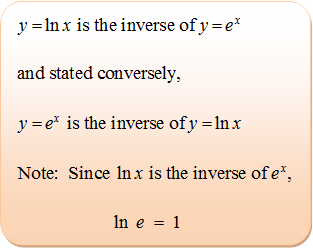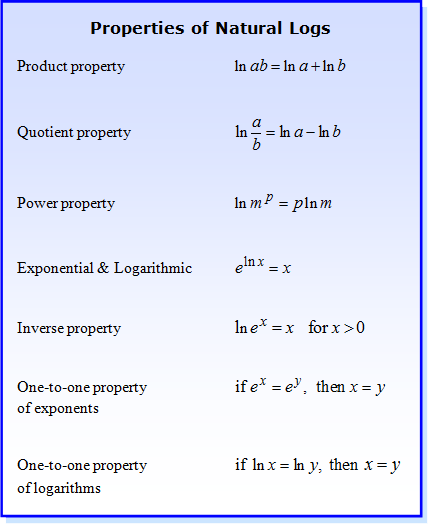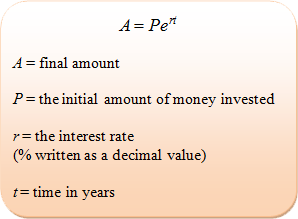NATURAL LOGARITHMS
 |
Unit Overview
In this unit you will evaluate natural exponential and natural logarithmic functions and model exponential growth and decay processes. You will also solve logarithmic and exponential equations by using algebra and graphs. Real world problems involving exponential and logarithmic relationships will be solved at the conclusion of the unit.
Natural Exponential and Natural Logarithmic Functions
The number e is an important irrational number. It is approximately equal to 2.71828. Like pi, the value is constant.
An exponential function with the base e is called a natural base exponential function. These functions are useful in describing continuous growth or decay. For example, the number e is used to solve problems involving continuous compound interest and continuous radioactive decay. Exponential functions with the base e have the same properties as other exponential function.
The natural logarithmic function y = log e x is abbreviated y = ln x and is the inverse of the natural exponential function
y = e x.
 |
Example #1: If e5 = 148.413, what is x in the expression ln x = 5?
*Note: The three triangular dots are an abbreviation for the word, “therefore”. |
||||||
Example #2: If ln 54.598 = 4, what is x in the expression ex = 54.598?
|
Let's practice changing exponential expressions of e to natural logarithms (ln), and vice versa. (Don't use a calculator; it's not necessary. Just follow the definition of the natural logarithm and how it relates to e.)
![]() If e3 = 20.086, what is x in the expression ln x = 3?
If e3 = 20.086, what is x in the expression ln x = 3?
x = 20.086
"Click here" to check the answer.
![]() If e−2 = 0.0135, what is x in the expression ln 0.0135= x?
If e−2 = 0.0135, what is x in the expression ln 0.0135= x?
x = −2
"Click here" to check the answer.
![]() If ln 7.389 = 2, what is x in the expression e2 = x?
If ln 7.389 = 2, what is x in the expression e2 = x?
x = 7.389
"Click here" to check the answer.
![]() If ln 1 = 0, what is x in the expression e0 = x?
If ln 1 = 0, what is x in the expression e0 = x?
x = 1
"Click here" to check the answer.
![]() If e = x, what is the value of x?
If e = x, what is the value of x?
x = 1
"Click here" to check the answer.
The Calculator and the Natural Log (LN
) The key marked LN on the calculator is the natural logarithm key. |
Example #1: Evaluate the expressions using a calculator.
|
Properties of common logarithms (log) apply to natural logarithms (ln) as well.
 |
Example #2: Express 3 ln 5 as a single natural logarithm.
|
Example #3: Express ln 35 – ln 5 as a single natural logarithm.
|
Example #4: Express 2 ln x + 3 ln y + ln 8 as a single natural logarithm.
|
Stop! Go to Questions #1-8 about this section, then return to continue on to the next section.
Solving Equations with Natural Logarithms
Now let’s take a look at using the natural log to solve an equation.
Example #1: Solve 6.5x = 44 for x.
To check the above problem, substitute 2.02 in for x in the original equation.
*Note: This problem can also be solved by taking the common logarithm (log) of both sides of the equation. |
||||||||||||||
Natural logarithms (ln) must be used to solve problems that contain the number e.
Example #2: Solve ex = 40 for x.
|
Example #3: Solve
|
Example #4: Solve 8e2x−5 = 56 for x.
|
Example #5: Solve 500 = 100e0.75t for t.
|
Example #6: Solve ln (10x) = ln(3x + 14) for x.
|
Example #7: Solve ln x + ln (x − 3) = ln 10 for x.
Check both of these answers in the original problem. If either solution results in a negative logarithm, that solution must be denied.
|
Stop! Go to Questions #9-14 about this section, then return to continue on to the next section.
Applications of Natural Logarithms
A formula using natural logarithms is the continuous compound interest formula where A is the final amount, P is the amount invested, r is the interest rate, and t is time.
 |
Example #1: Find the value of $500 after 4 years invested at an annual rate of 9% compounded continuously.
*On the calculator there is a feature for inputting ex. That feature is found by pressing 2nd LN. Notice there is an ex above the LN button. Press 500, then 2nd LN, then (0.09 × 4). Press enter and the answer appears!
|
Example #2: How long will it take to double your money if you deposit $500 at an annual rate of 7.2% compounded continuously?
|
||||||||||||||||
Stop! Go to Questions #15-30 to complete this unit.


